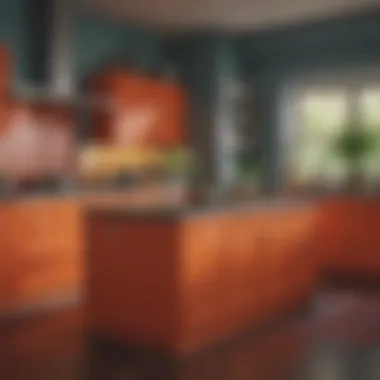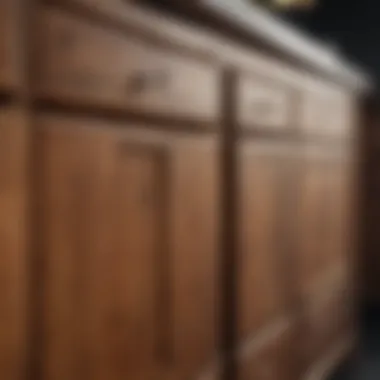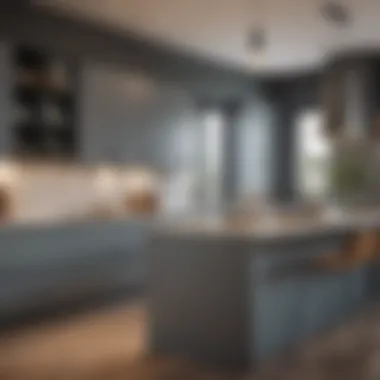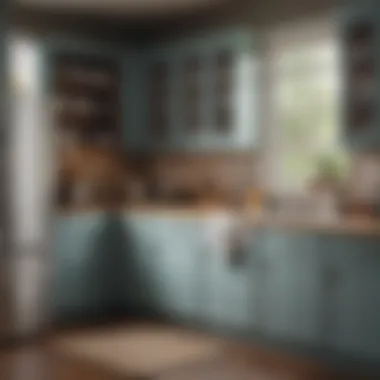The Ultimate Guide to Painted Solid Wood Cabinets


Intro
Painted solid wood kitchen cabinets are a popular choice for homeowners looking to enhance the aesthetic and functionality of their kitchens. This guide aims to cover main aspects related to painted solid wood cabinets, making it a valuable resource for homeowners, designers, and DIY enthusiasts. From understanding design inspiration to maintenance tips, readers will find comprehensive insight into this versatile cabinetry option.
Painted cabinets offer various aesthetic attributes that contribute to modern kitchen design. The process of painting solid wood not only adds color but also provides a protective layer, improving durability. As preferences in interior design evolve, so do the trends surrounding cabinetry, leading to the need for updated knowledge in this area.
An informed decision regarding kitchen cabinets involves understanding the materials used, the painting process, and the various design trends that cater to diverse tastes. With painted cabinets, one can explore a range of colors and finishes that satisfy practical needs while maintaining visual interest. This guide aims to compile essential points that will help in the selection and care of painted solid wood kitchen cabinets.
Preamble to Painted Solid Wood Kitchen Cabinets
Painted solid wood kitchen cabinets represent a compelling choice for homeowners and design enthusiasts aiming to blend durability with aesthetic appeal. This section underscores the importance of these cabinets in modern kitchen design, articulating how their construction and finish contribute to both functionality and beauty.
The use of solid wood as a base material provides substantial benefits. Unlike particleboard or MDF, solid wood possesses a natural strength and resilience. There are not only aesthetic advantages but also practical considerations. The longevity of solid wood cabinets means that homeowners are investing in a component of their kitchen that can withstand the rigors of daily use while maintaining its visual charm over decades.
Moreover, painting these cabinets enhances their design versatility. Homeowners can experiment with colors and finishes to suit their unique preferences and match them with overall kitchen decor. The ability to transform an ordinary kitchen into a sophisticated space is significant in today’s design landscape.
Key Benefits of Painted Solid Wood Cabinetry:
- Customization: Homeowners can choose from a myriad of colors, enabling a personalized touch.
- Durability: Solid wood offers structural integrity and resistance to warping or cracking.
- Sustainability: Solid wood can be sourced from sustainably managed forests, reducing environmental impact.
- Resale Value: Well-crafted cabinets can enhance property value, appealing to future buyers.
As we explore the nuances of painted solid wood kitchen cabinets, it becomes evident that they cater to both functionality and style. This guide aims to delve into the various aspects surrounding them, offering insights that can aid informed decision-making in kitchen renovations or builds. Understanding the essentials about these cabinets not only aids homeowners but also serves designers and DIY enthusiasts looking to create inviting and enduring spaces.
"The beauty of painted solid wood cabinets lies in their ability to adapt to changing tastes while remaining timeless in their appeal."
Thus, this introduction serves as a foundation as we further dissect the material characteristics, design considerations, and maintenance strategies that come into play with painted solid wood kitchen cabinets.
Understanding Solid Wood as a Material
Understanding solid wood as a material is crucial in the context of painted kitchen cabinets. Solid wood provides a blend of quality, beauty, and durability that synthetic materials cannot match. When homeowners consider cabinetry options, solid wood stands out due to its natural appeal and strength. Unlike composite materials, which can warp or lose integrity over time, solid wood retains its robustness. Therefore, selecting the right type of wood greatly influences both the aesthetic and functional aspects of the kitchen.
Characteristics of Solid Wood
Solid wood is renowned for its unique characteristics. Each piece has its own grain pattern, texture, and color, which adds individuality to every cabinet. Furthermore, it ages gracefully, developing a richer patina over time. The structure of solid wood allows for ease of refinishing. This means if the paint begins to chip or fade, the cabinets can be sanded down and repainted without compromising the integrity of the wood.
Additionally, solid wood shows excellent resistance to wear. With appropriate care, solid wood cabinets can last for decades. They do require maintenance to ensure they remain visually appealing and functional. Regular cleaning and occasional refinishing can enhance their lifespan significantly.
Types of Wood Commonly Used
Maple
Maple is a highly sought after choice for kitchen cabinets. Known for its durability, maple possesses a fine grain that provides a smooth surface. Its light color offers versatility for various paint styles. Maple’s strength makes it less likely to dent and scratch, providing long-term value.
However, while maple is excellent for painted finishes, its density can make it challenging for some to work with during installation. Still, most consider the effort worthwhile given maple’s aesthetic and functional advantages.
Oak
Oak is a classic wood choice in cabinetry, known for its robust characteristics. It has a prominent grain pattern that can enhance the visual appeal of painted cabinets. Oak is incredibly durable, making it suited for heavy-use kitchens. Its natural stain capabilities complement various painting options.
On the downside, oak can be heavy and may require additional support structures during installation. This might be a consideration for some homeowners when choosing their cabinetry.
Cherry
Cherry offers a warmer aesthetic, with a rich reddish hue that ages beautifully over time. It is less dense than maple or oak, which makes it easier to work with during construction. Cherry wood can take paint well, although many homeowners appreciate its natural color and opt for clear finishes instead.
Cherry’s tendency to darken and develop a rich, deep color adds to its charm. However, this can be seen as a disadvantage for those who prefer a lighter look in their kitchen.


Hickory
Hickory is another popular choice, known for its hardness and shock resistance. It features a striking contrast of lighter and darker tones, making it visually unique. When painted, hickory provides a distinct look that can enhance the kitchen's overall design.
Nonetheless, its strength comes with the challenge of working with hickory. Because of hickory's density, it can be more difficult to cut and shape for cabinetry, which may impact some homeowners' decisions.
Advantages of Solid Wood Cabinets
Solid wood cabinets offer significant advantages over other materials. Firstly, they possess a timeless appeal that can elevate any kitchen design. Their natural beauty complements a wide array of styles.
Moreover, solid wood ensures durability. If maintained properly, they can last for generations. Their ability to be refinished allows for easy updates without full replacements. Lastly, the environmental impact is often less than that of manufactured wood products, especially when sourced sustainably.
In summary, solid wood cabinets provide a balance of beauty, functionality, and longevity. Understanding the various types of wood and their benefits allows homeowners to make informed choices for their kitchens.
The Painting Process for Kitchen Cabinets
The painting process plays a crucial role in transforming solid wood kitchen cabinets. Proper painting not only enhances aesthetic appeal but also maximizes the durability of the cabinets. Understanding the steps involved in this process, and choosing the right techniques and materials, contributes significantly to achieving a professional finish.
Preparation and Materials Needed
Preparation is key when it comes to painting kitchen cabinets. This phase involves several important steps:
- Cleaning the Cabinets: Remove all dirt and grease from surfaces. Not doing this can lead to paint not adhering properly.
- Sanding: Sanding helps in creating a smooth surface. Use fine-grit sandpaper to avoid deep scratches. This is also a good opportunity to remove previous finishes.
- Priming: Applying a primer is essential, especially for wood cabinets. This step provides a good base for the paint to stick to, which helps in longevity.
- Materials Needed:
- High-quality paint suitable for cabinets
- Primer
- Sandpaper (fine and medium grit)
- Brushes or sprayers, depending on the chosen technique
- Drop cloths to protect the area
- Masking tape to avoid paint on unwanted areas.
Techniques for Professional-Quality Finishes
Achieving a professional quality finish requires the right technique. Here are three common methods:
Spraying
Spraying is a popular method for its ability to create a smooth, even coat. The key characteristic of spraying is its efficiency. Large surfaces can be covered quickly, which saves time. The unique feature of this method is its ability to reach intricate details easily. However, overspray can be a concern, requiring careful setup and protective measures. Spraying provides a sleek finish but demands some practice for precise control.
Brushing
Brushing is another established technique. It requires less equipment than spraying and allows for better control of paint application. The key characteristic of brushing is that it works well on small projects. The unique feature is that it can create texture, which some find appealing. However, brushing may show brush strokes more visibly, depending on the paint used, and can also take more time to complete.
Rolling
Rolling is a third technique suitable for flat surfaces. The key characteristic of rolling is that it allows for quick coverage. It is especially effective on larger, flat areas like cabinet doors. The unique feature of rolling is the ability to create a uniform texture, but it may require several passes to achieve full coverage. Rolling can be easier for beginners, but achieving a smooth finish may be tricky without experience.
Choosing the Right Paint
Selecting the appropriate paint is critical for the painting process. The right paint enhances both the look and durability of kitchen cabinets.
Acrylic vs. Oil-Based
Acrylic paints have gained popularity due to their ease of use and quick drying times. They offer flexibility and are less smelly than oil-based paints. The unique feature of acrylic is its ability to resist yellowing over time. However, they may not be as durable on their own. On the other hand, oil-based paints provide a hard finish that is usually more durable. The disadvantage is that they take longer to dry and require solvents for cleanup.
Gloss vs. Matte Finishes
The finish sheen greatly affects the final look of the cabinetry. Glossy finishes tend to be more durable and are easier to clean, making them a practical choice for kitchens. Their sheen reflects light, giving a modern appearance. Matte finishes, while less glossy, can hide imperfections better and provide a warmer feel. However, they may not hold up against frequent cleaning as well as gloss finishes do. Choosing the right finish often comes down to personal preference and practical needs.
Design Considerations for Painted Cabinets
When choosing painted solid wood cabinets for a kitchen, design considerations play a vital role. They not only affect the aesthetic value but also the functionality and longevity of the cabinets. The colors, styles, and overall design impact the kitchen's ambiance and usability. Making informed choices in these areas ensures that cabinets complement the space while meeting functional needs and personal preferences.


Color Trends and Psychology
Color trends in kitchen design often reflect broader cultural movements and can greatly influence the space's feel. Different colors evoke different emotions. For instance, blues can create a calm atmosphere, while yellows add warmth. Understanding the psychology behind colors helps homeowners make choices that resonate with their tastes and the desired kitchen environment.
Some popular color trends include:
- Soft Neutrals: These provide a serene backdrop and pair well with various design elements.
- Bold Colors: Drawing attention, bold hues can act as focal points in modern kitchens.
- Earthy Tones: These colors bring a natural feel to the space and promote a cozy atmosphere.
When selecting colors, consider how they harmonize with other design elements, such as countertops, flooring, and wall colors.
Style Alignment with Kitchen Design
Aligning cabinet styles with the overall kitchen design is crucial for a cohesive look. Below are popular styles, each with distinct characteristics, benefits, and unique features.
Modern
Modern kitchen design emphasizes clean lines and minimalism. The use of flat panel doors and sleek finishes is common. This style is often beneficial for smaller kitchens, as it can create an illusion of space and clutter-free zones. The simplicity of modern cabinets allows for added versatility when pairing with contemporary appliances and fixtures. However, this style may not suit everyone, as some prefer more intricate designs.
Rustic
Rustic style often emphasizes nature and warmth. Cabinets that are painted in warmer, earthy colors fit well within this aesthetic. This style creates a homey atmosphere and pairs beautifully with natural materials like wood and stone. The rugged finish on rustic cabinets can hide wear and tear, making them a practical choice for busy families. Yet, they may require more maintenance to keep their intended appearance.
Traditional
Traditional kitchen design is characterized by classic details. Incorporating painted cabinets in shades like cream or deep navy can enhance this timeless look. These cabinets often have more elaborate moldings and trim, adding elegance to the kitchen. While traditional styles may seem inviting, they can also require regular upkeep to maintain their appearance over the years.
Understanding these various styles can help in making informed decisions that enhance the overall kitchen experience.
By carefully considering the design aspects of painted cabinets, homeowners can select options that not only meet their functional needs but also reflect their personal style.
Functional Benefits of Painted Cabinets
Painted solid wood kitchen cabinets offer not just visual appeal but also significant functional advantages for homeowners, interior design enthusiasts, and even DIY aficionados. Understanding these benefits is crucial in making informed decisions when selecting cabinetry for kitchen spaces.
These cabinets are not only aesthetically pleasing but also practical. This section delves into two primary functional benefits: their maintenance ease and customization options. Both benefits enhance the usability of these cabinets, making them a practical choice for any kitchen.
Easier Maintenance and Cleaning
One of the standout benefits of painted solid wood cabinets is their ease of maintenance. Often, kitchens are bustling spaces filled with cooking activities. This can lead to stains, spills, and grime accumulation. The smooth, painted surfaces of these cabinets allow for quick and effective cleaning.
Using a damp cloth with mild soap often suffices to remove dirt and grease. The following are practical maintenance tips:
- Regularly wipe down surfaces to avoid build-up.
- Use non-abrasive cleaners to prevent damage.
- Immediately address spills to maintain the appearance.
Furthermore, painted surfaces can be more resistant to scratches and dents compared to bare wood. This characteristic extends the lifespan of the cabinets. In high-traffic kitchens, this durability becomes an essential aspect, ensuring that cabinets withstand daily wear and tear without significant signs of aging.
"Maintaining cabinets shouldn't be a chore; simplicity in cleaning can drastically enhance your kitchen experience."
Customization in Everyday Use
Another critical advantage is the high degree of customization available with painted cabinets. Homeowners have the flexibility to choose colors and finishes that align with their personal style and overall kitchen design. This made these cabinets a preferred option in various design themes, from modern to rustic.
Customization options often include:
- Color Selection: Homeowners can choose from an extensive palette to match or contrast with other kitchen elements.
- Finish Choices: Options range from matte to high-gloss, providing different levels of sheen based on preference.
- Hardware Variations: The selection of knobs and pulls further personalizes the cabinets, enhancing functionality and aesthetics.


Customizing the cabinets also helps in maximizing storage. By considering organization needs and the spatial layout, homeowners can optimize cabinet features like shelves and compartments, tailored to everyday use. This practical approach turns the kitchen into an efficient workspace.
Environmental Impact of Choosing Wood Cabinets
The choice of wood cabinets, particularly painted solid wood, carries significant environmental implications. Understanding these effects can guide homeowners in making responsible decisions that align with their values regarding sustainability and environmental stewardship. Considerations range from sourcing practices to the longevity of materials used in cabinetry construction and finishes. It is vital to focus on fostering a positive environmental impact and reducing any adverse effects associated with kitchen cabinetry.
Sourcing Sustainable Wood
Sourcing sustainable wood is crucial in mitigating the negative impact on forests and ecosystems. When selecting wood for kitchen cabinets, one should prioritize materials harvested from responsibly managed forests. Certifications from organizations such as the Forest Stewardship Council (FSC) ensure that the wood comes from sources that meet strict environmental and social standards.
Here are some points to consider:
- Types of Sustainable Certifications: Look for third-party certifications to verify the sustainable practices.
- Local Sourcing: Whenever possible, choose wood sourced locally, as this reduces transportation emissions and supports local economies.
- Reclaimed Wood: Utilizing reclaimed wood is an excellent way to repurpose existing resources and minimize deforestation.
By pursuing sustainable sources, homeowners can contribute to the preservation of forests and reduce the ecological footprint of their kitchen renovations.
The Role of Eco-Friendly Paints
The significance of eco-friendly paints in the realm of painted solid wood cabinets cannot be overstated. Conventional paints often contain harmful chemicals that can off-gas volatile organic compounds (VOCs), contributing to indoor air pollution. Selecting eco-friendly options not only protects your family’s health but also has a positive influence on the environment.
Here are some essential aspects to consider when selecting eco-friendly paints:
- Low-VOC and Zero-VOC Options: Choose paints labeled as low or zero VOCs to minimize harmful emissions.
- Natural Ingredients: Look for paints made from natural ingredients, such as milk proteins or plant-based oils, which are less harmful and more biodegradable.
- Durability: Eco-friendly paints can be as durable as their conventional counterparts. This durability often results in fewer repainting jobs over time, leading to lower environmental impact.
Implementing eco-friendly paints enhances the overall sustainability of the cabinetry, making a lasting positive contribution to both the kitchen space and the environment.
Common Myths About Painted Wood Cabinets
When considering painted solid wood kitchen cabinets, various misconceptions often arise, which can mislead homeowners and designers alike. Understanding these myths is essential for anyone looking to invest in quality cabinetry. This section aims to clarify persistent beliefs about painted wood cabinets, addressing their durability, maintenance, and other important factors. By dispelling these myths, potential buyers can make more informed choices about their kitchen cabinetry.
Durability and Longevity Misconceptions
One of the most common myths surrounding painted wood cabinets is that they are less durable than their untreated counterparts. Many people believe that paint compromises the integrity of the wood, leading to chipping and splitting over time. However, this often depends on the preparation and finishing process used during painting.
- Proper Preparation: A well-prepared surface is foundational for durability. Sanding the wood correctly and applying a suitable primer can significantly enhance paint adhesion. This prevents chipping and peeling, even in high-traffic areas of the kitchen.
- Quality of Materials: The type of paint used also matters. Acrylic paints, for example, offer flexibility and resistance to cracks while oil-based paints provide a harder finish. Either choice can work but must align with intended use and environmental conditions in the kitchen.
- Protective Finishes: Clear protective coatings can be applied over painted surfaces to further guard against wear and tear. These coatings can help in maintaining the aesthetic appearance and longevity of painted cabinets.
It is crucial to acknowledge that when done properly, painted solid wood cabinets can very well outlast other materials like laminate.
"A well-maintained painted wood cabinet is often more durable than is commonly believed."
Maintenance Misunderstandings
Another prevalent myth revolves around the maintenance of painted wood cabinets. Some people assume that painted surfaces require exorbitant upkeep, leading them to opt for alternatives that may not offer the same aesthetic appeal or durability. In reality, while painted cabinets do require some care, the effort is often manageable.
- Routine Cleaning: Regular cleaning with mild soap and water is usually sufficient to keep painted cabinets looking fresh. Harsh chemicals or abrasive cleaners are unnecessary and can damage the finish.
- Addressing Scuffs and Scratches: Minor damage can often be repaired easily. Touch-up paint specific to the cabinet's color can be used, allowing homeowners to maintain the cabinet's appearance without extensive labor.
- Humidity and Heat: It is essential to avoid exposing these cabinets to extreme humidity or direct heat, which can affect the paint’s integrity. Kitchen environments are naturally prone to such challenges, but basic precautions, like using a range hood, can mitigate these factors.
On the whole, the maintenance required for painted wood cabinets is comparable to that of other materials, if not less depending on high-quality workmanship and finish. Those who understand the true nature of maintaining these cabinets will find them a valuable addition to any kitchen.
Closure: Making Informed Choices
In painting solid wood kitchen cabinets, the importance of making informed choices cannot be overstated. This guide has illuminated various aspects of cabinetry, from understanding the material to exploring the painting process, design considerations, and sustainability. These insights empower homeowners and designers to select cabinets that not only meet aesthetic desires but also align with practical needs and environmental considerations.
Choosing the right cabinets involves several key elements. First, understanding the characteristics of solid wood as a material forms the foundation for quality decisions. The durability and longevity of solid wood, combined with the proper painting methods, result in cabinets that withstand daily use while maintaining their visual appeal.
Moreover, design trends play a crucial role in selecting cabinetry. Knowing how color psychology and style alignments can affect the kitchen atmosphere leads to choices that enhance the overall harmony of the space. Embracing current aesthetic trends, whether modern or rustic, ensures that the selected cabinets will remain relevant and stylish for years to come.
When it comes to paint selection, understanding the differences between acrylic and oil-based finishes is vital. Each paint type carries its own benefits and drawbacks, impacting both appearance and maintenance. This knowledge transcends mere preference; it ensures that the chosen finish will perform well under kitchen conditions, such as exposure to heat and moisture.
Environmental considerations are increasingly critical in consumer decisions. Sourcing sustainable wood and opting for eco-friendly paint are choices that contribute positively to the planet. Knowledge about these aspects affects not only personal choices but also broader implications for environmental health.
"The more informed choices we make today will have lasting impacts on our living spaces and the world we inhabit."
As emphasized throughout the article, thorough research and awareness will ultimately lead to satisfaction and success in selecting cabinets. Making informed choices ensures that both the aesthetics and functionality of kitchen cabinetry align beautifully.



